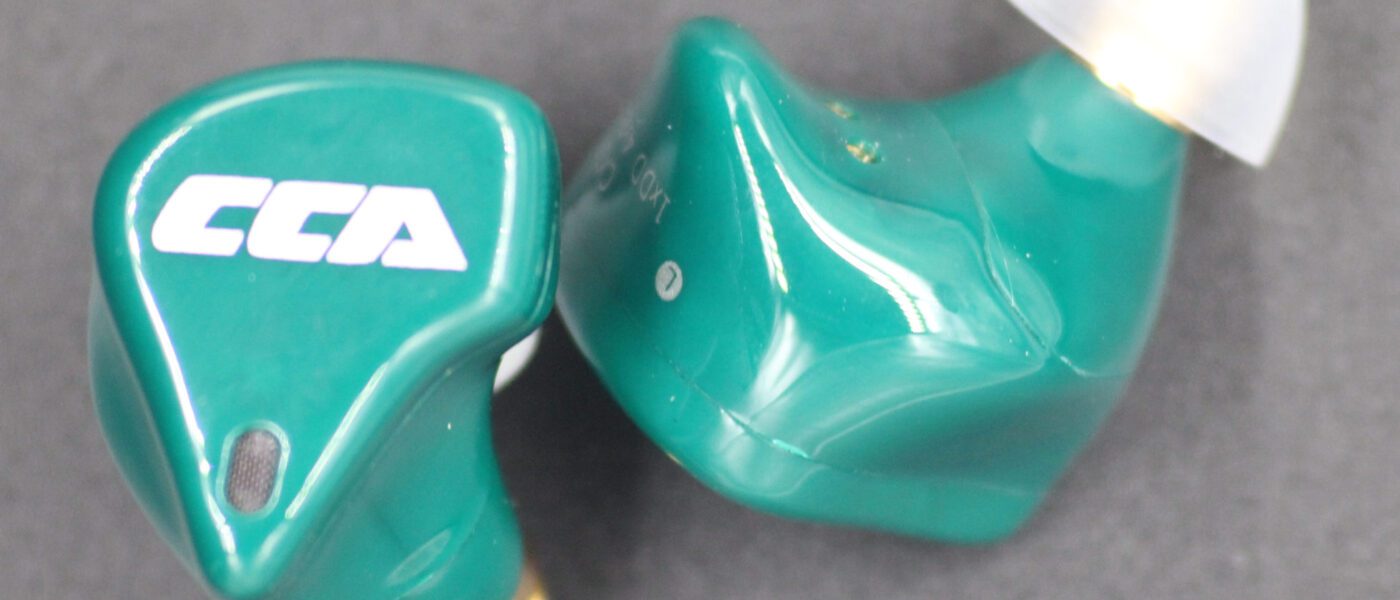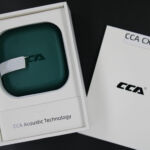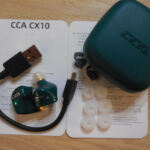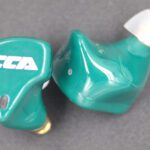CCA CX10
disclaimer: disclaimer: The CCA CX4 and CX10 were provided for purposes of review by Better Audio. I have no financial interest in CCA, KZ, or Better Audio and have not received any compensation for this review. If you have an interest in the CX10 you can get more information from the Better Audio’s store on Amazon.
Unboxing / Packaging:
The CX10 comes shipped in a white lift top style box with the CCA logo on the front and model details on a sticker on the side. I found this a bit odd as the packaging on its less expensive sibling is more sophisticated and shows more attention to detail than does the CX10. Internal packaging is a bit better with the case in a plastic support and a small box hiding the cable and tips rather than those items being loose under the plastic tray like the CX4 was. The kit is also a dead ringer for its small sibling with three sets of silicone tips in small, medium, and large, a micro-usb cable for charging and the manual rounding out the kit.
Build/Fit:
Shells are a multi-part design with the bulk being resin bonded to a brass nozzle. The shell is comprised of a 4 major parts, a faceplate, main body (the bulk of the inner shell), an inner resin plate that attaches the nozzle, and the brass nozzle itself. Seems are well fitted but very visible and detract from the semi-custom shape of the earpieces. The Earpieces have 2 vents, one at the lower edge of the faceplate (a vertical oblong arrangement) and the other much smaller at the top edge along the junction of the faceplate and main body near where the model name is printed. The inner surface has a pair of charging pads that are slightly counter sunk in the resin to avoid contact with the ear. Nozzles have a distinct forward rake and a pronounced lip for tip retention. Insertion depth is fairly deep, but isolation is only average due to the size and venting.
Internals:
The CX10 uses a 7mm dual magnet dynamic driver for the lows, a pair of 50024 balanced armatures for the mids and a pair of 30095 armatures for the highs. Sensitivity is listed as 91dB/mW but no impedance is listed. I searched a good bit looking for what bluetooth chip was in use but was unable to find a definitive answer. It does support Bluetooth 5.0 but is limited to SBC and AAC with no support for AptX HD or LDAC which is a little disappointing considering the competition increasingly supports these protocols. The battery in each earpiece is listed as a 40mA lithium ion cell and my testing showed actual capacity to be roughly that as well. I found Bluetooth range to be good in open space, but easily defeated by walls (even cubicle walls). With AAC on, the CX10 had solid connectivity but in SBC mode cut-outs were fairly common. Gaming mode introduces a lower latency but connectivity was roughly between AAC and SBC and not being a big gamer, I didn’t really test it fully.
Case:
The case is a plastic clamshell design with CCA cast into the lid and a single micro-USB port on the right hand side. Inside the case there is a single LED indicator between the recesses for the two earpieces. The case itself houses a 400mAh lithium ion battery and charge circuitry. The LED lights red while charging and green when full charge is reached. During the charging process, if when disconnected the LED is red the case is between 0-30% charged, if yellow 30-70% and green = above 70%. It would be nice to have some indicator on the shell’s exterior for this as you have to open the case to see the charge state. I found battery life of the earpieces to be roughly 2.5 hours depending on listening volume.
Function/Controls:
When using the CX10, you have to take both earpieces out of the case at roughly the same time or it will connect in mono mode as they can be used as a single earpiece for phone conversations if desired. They have the familiar red/blue blink when pairing and then go to red /blue alternating on master (slower blink) and flashing blue on slave when paired. There is also an audible prompt for pairing and paired as well.
To turn them on or off when outside the case, touch and hold the face of each earpiece. 3 seconds should be enough to turn them on but to turn them off takes 6 seconds of constant contact with the face. Also if placed back into the case, the units will automatically power off and charge then power on when removed from the case.
Similarly quick taps of the face can be used to control playback during use. A single tap is play/pause or can be used to answer/hang-up calls. if you touch and hold the face plate the call is rejected or if no call is present and your device suports it, a press and hold will activate Siri. Two quick taps to the left is previous, two taps to the right is next. Three quick taps to the earpiece enters low latency mode for games or movie watching.
Sound:
I didn’t end up doing the normal FR chart here as I had problems getting the CX10 to behave wheile trying to do so as it consistently only gave 50% effort so I ended up with a disjointed mess instead of a normal looking FR. Not sure what the issue is as I tried my normal test setup and also tried with the Hiby R3 pro as a usb DAC from the test laptop as the middle man and got the same results both times. I threw a couple other TWS models at the test system to be sure and those all worked as expected. I think the issue is inherent to the chipset in the CX10 rather than with the measurement rigs as I also saw the same problem with its sibling the CX4 that uses the same chipset.
Bass:
Sub-bass is emphasized and has good depth and rumble, but can get a little loose at times much like its smaller sibling. Mid-bass is also emphasized with good slam, but here again a bit looser than it should be with more than a little bleed into the mids and some obstruction of detail due to the lack of control.
Mids:
The CX10 has more detail in the mids by far when compared to the CX4 but retains a similar signature with a dip in the lower mids and a climb again in the upper-mids/lower treble. Male vocals have good tonality and weight. Guitar growl is a bit sharper than the CX4 as well. Strings have a bit more realistic tone but still lack a bit of energy to be entirely realistic. Female vocals are a step forward of their male counterparts and have a bit more energy as well. This is a double edge sword as good recordings will do well but recordings on the hot side can get a bit fatiguing as a result.
Treble:
Lower treble continues the rise of the upper-mids before plateauing as it reaches the true treble. Treble is roughly equal in emphasis as the mid-bass hump. The highs are notably more detailed than its little brother but share a similar smoothing and stay away from being overly fatiguing. Snare rattle is good with sharp attack and cymbals have more energy than the CX4 but can be a little metallic at times. Extension is good with enough air and sparkle at the top to keep from feeling closed in.
Soundstage / Imaging:
Stage has good depth and is a bit deeper than it is wide. This is the biggest departure from its little brother which is all width and little else. The CX10 has some height and feels like a large auditorium or theatre. Seating the orchestra is fairly straight forward with front/back and side by side relationships easily heard. Instrument separation is good and helps in this respect and while come compression is evident in the lows, the fact that only frequencies below about 400Hz are being handled by the dynamic driver limits the impact that has. Imaging is good with movements fairly easily tracked and positions tightly defined. I did find the stage center a bit cleaner than the little brother as well.
Thoughts / Conclusion:
The CX10 doesn’t have a direct sibling in the KZ line. The Sa08 is probably the closest, but the CCA uses a dynamic driver for bass while the KZ uses an armature. I struggle with finding the value in the CX10 as it has limited connectivity options with no LDAC or AptX HD support, and shares too many features with the CX4 to ignore. While the sound signature is a bit more detailed, it still shares a similar signature and those who don’t like the way the CX4 sounds probably won’t appreciate the CX10 either. If the CX10 was $10 more than the CX4 it would be an easy recommendation, but with the CX10 commanding more than double the price of the CX4, I’m not sure the value proposition is still there. If you have a CX4 and want a more detailed version of it, the CX10 fits the bill, if you want a V shaped in ear for gym use, either the CX4 or CX10 will work, but the 10 will cost you a bit more.
-
Bass - 6/106/10
-
Mids - 6.5/106.5/10
-
Treble - 7/107/10
-
Soundstage - 7/107/10
-
Imaging - 7/107/10
Summary
Pros: Good detail, good fit for active use, easy controls
Cons: V-signature, limited battery life, bass a bit loose.
















